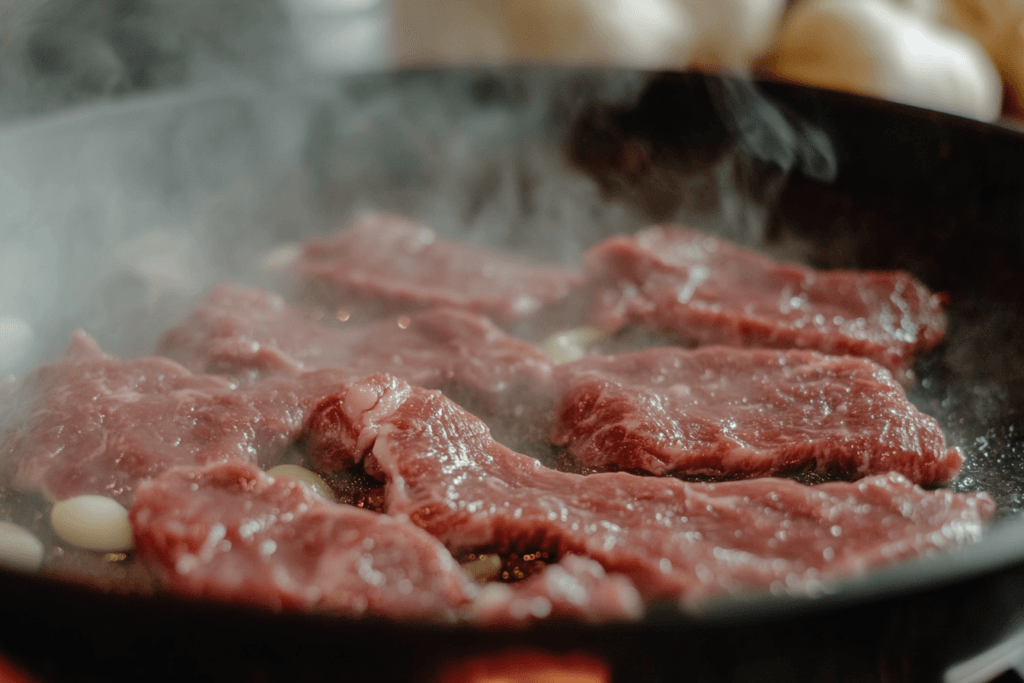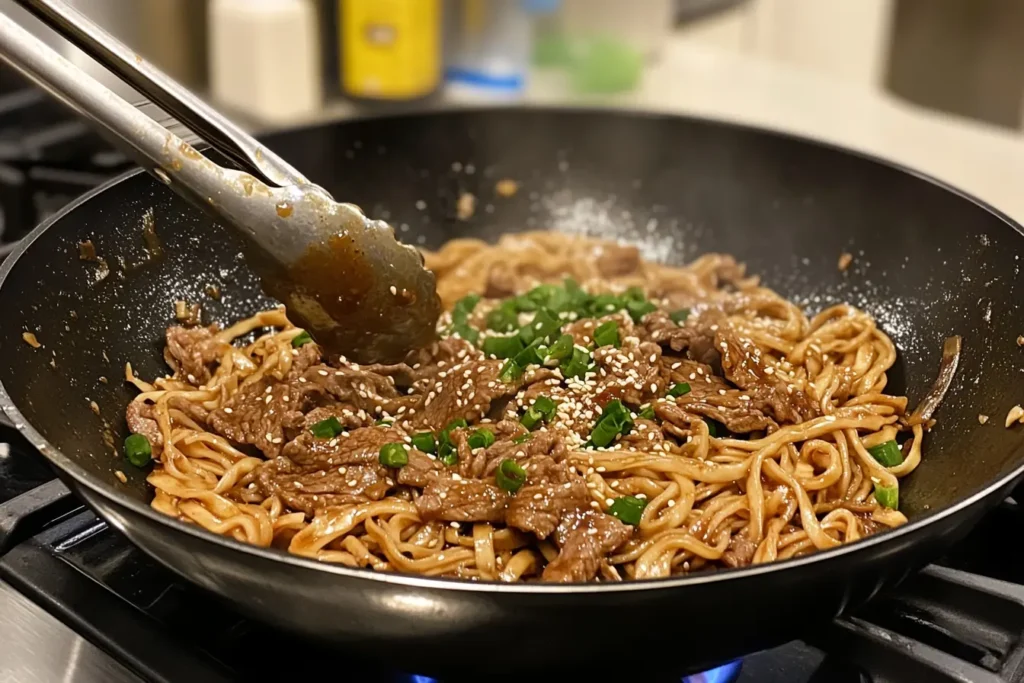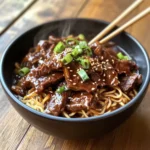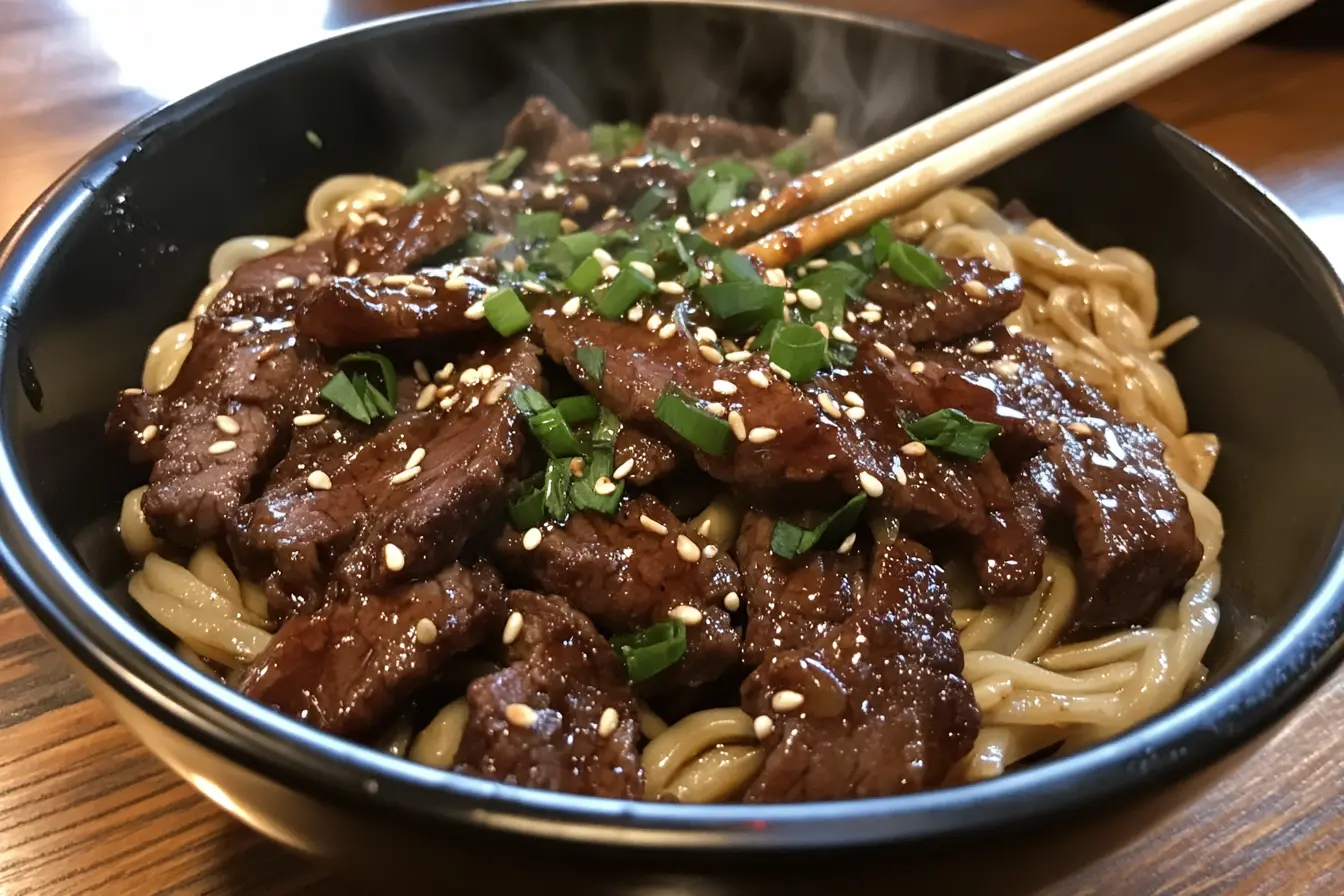Mongolian Beef Noodles is a mouthwatering dish that combines the rich flavors of Mongolian beef with the heartiness of stir-fried noodles. This dish is known for its perfect balance of sweet, savory, and slightly spicy flavors, all wrapped in a glossy, caramelized sauce. The tender slices of beef, crispy yet chewy noodles, and aromatic garlic and ginger create a meal that rivals any takeout restaurant.
What Are Mongolian Beef Noodles?
Mongolian Beef Noodles is a fusion of two beloved Asian-style dishes: Mongolian Beef and stir-fried noodles. While traditional Mongolian beef is typically served with rice, this version swaps out the rice for stir-fried noodles, which absorb the flavorful sauce beautifully. The result is a rich, satisfying, and easy-to-make dish that’s perfect for weeknight dinners or special occasions.
If you’re looking for another fantastic beef dish, try this Beef Stir Fry Recipe, which showcases similar flavors and techniques.
Table of Contents
Ingredients for Mongolian Beef Noodles
To make delicious Mongolian Beef Noodles, you’ll need a combination of fresh ingredients, the right cut of beef, and a flavorful sauce. Below is a detailed breakdown of everything you need for this dish.
Essential Ingredients
Here are the key ingredients you’ll need to make Mongolian Beef Noodles:

- Beef: Thinly sliced, tender beef is crucial for this dish.
- Noodles: A chewy noodle variety works best.
- Soy Sauce: Adds a rich umami depth to the sauce.
- Brown Sugar: Provides a subtle sweetness to balance the saltiness.
- Garlic & Ginger: Essential aromatics that give the dish its signature flavor.
- Cornstarch: Helps tenderize the beef and thickens the sauce.
- Oyster Sauce: Adds a layer of savory, slightly sweet depth.
- Sesame Oil: Provides a toasty, nutty aroma.
- Green Onions: Used for garnish and mild onion flavor.
- Vegetable Oil: For stir-frying.
- Red Pepper Flakes (Optional): Adds heat for those who like a spicy kick.
Looking for a side dish? Pair it with French Onion Butter Rice for a rich and comforting complement.
Best Cuts of Beef for Mongolian Beef Noodles
To get tender and juicy beef, it’s important to choose the right cut. Here are the best options:
- Flank Steak: The most popular choice, as it is lean and tender when sliced properly.
- Sirloin Steak: A budget-friendly option that still delivers good tenderness.
- Ribeye: A more luxurious choice with extra marbling, making it extra flavorful.
Tip: Always slice the beef against the grain to ensure tenderness.
Choosing the Right Noodles
The best noodles for Mongolian Beef Noodles should have a slightly chewy texture to absorb the sauce well. Here are some great options:
- Lo Mein Noodles: A classic choice that’s soft but holds up well in stir-fries.
- Rice Noodles: A gluten-free alternative that soaks up flavors beautifully.
- Ramen Noodles: Adds extra chewiness and work well in this dish.
- Egg Noodles: Provide a rich, slightly buttery flavor.
Key Sauce Components
The Mongolian sauce is the heart of this dish, and here’s what makes it so flavorful:
- Soy Sauce: Use a mix of regular and low-sodium soy sauce for balance.
- Brown Sugar: Creates a glossy, caramelized effect when cooked.
- Garlic & Ginger: These aromatics enhance the umami flavors.
- Oyster Sauce: Adds depth and extra savoriness.
- Cornstarch Slurry: Helps thicken the sauce for a silky texture.
Step-by-Step Cooking Instructions
Now that you have all the ingredients, let’s go through the process of making Mongolian Beef Noodles step by step. Follow these instructions for a flavorful, restaurant-quality dish.
Step 1: Preparing the Beef
- Slice the Beef Thinly
- Using a sharp knife, slice the beef against the grain into thin strips (about ¼ inch thick). This helps keep the meat tender.
- If the beef is too soft to cut evenly, place it in the freezer for 15–20 minutes to firm up before slicing.
- Coat with Cornstarch
- In a bowl, add 2 tablespoons of cornstarch to the sliced beef and toss until all pieces are lightly coated.
- Let it sit for 10–15 minutes. This step helps create a crispy texture when stir-fried and thickens the sauce later.

Step 2: Making the Signature Mongolian Sauce
- Mix the Sauce Ingredients
In a small bowl, combine:- ½ cup soy sauce (use a mix of regular and low-sodium for balance)
- ¼ cup brown sugar (for caramelization)
- 1 tablespoon oyster sauce
- 1 teaspoon sesame oil
- ½ teaspoon red pepper flakes (optional, for spice)
- ½ cup water
- Stir well until the sugar dissolves, then set aside.
Step 3: Cooking the Noodles
- Boil Water
- Bring a pot of water to a boil and add the noodles.
- Cook according to package instructions (usually 4–5 minutes for fresh noodles or 8–10 minutes for dried noodles).
- Drain and Rinse
- Once the noodles are soft but still chewy, drain them and rinse them with cold water to stop the cooking process.
- Toss them with 1 teaspoon sesame oil to prevent sticking.
For a creamy alternative, try One-Pan Chicken with Creamy Buttered Noodles.
Step 4: Stir-Frying the Beef
- Heat the Pan
- In a large wok or skillet, heat 2 tablespoons of vegetable oil over medium-high heat until shimmering.
- Cook the Beef
- Add the beef in a single layer and sear for 1–2 minutes per side until browned and crispy.
- Remove from the pan and set aside.
Tip: Do not overcrowd the pan! Cook the beef in batches if necessary.
Step 5: Stir-Frying Everything Together

- Sauté Garlic & Ginger
- In the same pan, add 1 tablespoon oil and sauté 3 cloves minced garlic and 1 teaspoon grated ginger for about 30 seconds, until fragrant.
- Add the Sauce
- Pour in the prepared Mongolian sauce and bring to a simmer.
- Return the Beef
- Add the cooked beef back into the pan and toss it to coat it in the sauce.
- Stir in the Noodles
- Add the cooked noodles and mix well to ensure they absorb the sauce.
- Stir-fry for another 2–3 minutes until everything is well combined.
- Garnish & Serve
- Sprinkle with sliced green onions and sesame seeds before serving.
- Serve it hot and enjoy!
Variations & Dietary Alternatives
If you love Mongolian Beef Noodles but want to customize the recipe to fit your dietary needs or taste preferences, here are some fantastic variations.
1. Low-Carb & Keto-Friendly Options
For those on a low-carb or keto diet, swap out the traditional noodles and sugar with these alternatives:
- Use Zucchini Noodles (Zoodles): A great low-carb alternative that absorbs sauce well.
- Try Shirataki Noodles: These “miracle noodles” are nearly zero carbs and mimic the texture of real noodles.
- Replace Brown Sugar with a Keto Sweetener: Use monk fruit sweetener or erythritol instead of brown sugar.
- Thicken with Xanthan Gum: Instead of cornstarch, use ⅛ teaspoon xanthan gum to thicken the sauce.
2. Vegan & Vegetarian Alternatives
To make Mongolian Beef Noodles meat-free, replace the beef with plant-based proteins:
- Use Tofu: Press and cube firm tofu, then pan-fry until crispy before adding to the stir-fry.
- Try Mushrooms: Portobello or shiitake mushrooms give a meaty texture.
- Go for Tempeh: Marinate and slice tempeh for a protein-packed alternative.
- Use Vegan Oyster Sauce: Regular oyster sauce contains seafood, so opt for a vegan version or use extra soy sauce.
3. Gluten-Free Adaptations
For a gluten-free version, use:
- Tamari or Coconut Aminos: Instead of soy sauce.
- Rice Noodles or Gluten-Free Ramen: Instead of wheat-based noodles.
- Cornstarch Instead of Flour: To thicken the sauce.
Serving Suggestions & Pairings
Mongolian Beef Noodles are a flavorful dish, and pairing them with the right sides and beverages can enhance the overall dining experience. Here are some excellent options to complement this meal.
Best Side Dishes
Adding a side dish can provide balance and variety to the meal. Some great options include:
- Garlic Bok Choy – A simple stir-fry with soy sauce and sesame oil that adds a fresh, slightly crunchy contrast.
- Steamed Broccoli – A nutritious addition that pairs well with the savory sauce.
- Egg Rolls or Spring Rolls – Crispy and filled with vegetables or meat, these make a great appetizer.
- Steamed Jasmine Rice – A neutral base that helps soak up any extra sauce for those who enjoy additional carbs.
- Asian Cucumber Salad – A light and refreshing salad made with rice vinegar and sesame seeds, providing a cool contrast to the warm noodles.
Drink Pairings
A well-chosen drink can balance the flavors of Mongolian Beef Noodles. Consider these options:
- Green Tea – A mild, aromatic tea that helps cleanse the palate.
- Chilled White Wine (Riesling or Sauvignon Blanc) – The acidity and slight sweetness of white wine complement the rich and slightly sweet sauce.
- Ginger Beer or Lemonade – Both provide a refreshing contrast to the dish’s bold flavors.
- Light Asian Beer (Tsingtao, Sapporo, or Kirin) – A crisp, mild beer enhances the umami flavors without overpowering them.
Frequently Asked Questions (FAQs)
1. Can I use a different protein instead of beef?
Yes, Mongolian Beef Noodles can be made with other proteins. Chicken, shrimp, or even pork can be used as substitutes. If using chicken, opt for boneless, skinless chicken breast or thighs. For shrimp, use large, peeled, and deveined shrimp, cooking them quickly to avoid overcooking.
2. What type of noodles work best for this recipe?
Lo mein noodles are ideal because they are chewy and absorb the sauce well. However, you can also use egg noodles, ramen, rice noodles, or even spaghetti if you don’t have Asian-style noodles on hand.
3. How can I make this dish less salty?
To reduce the saltiness, use low-sodium soy sauce and adjust the amount to taste. You can also add a splash of water or a teaspoon of rice vinegar to balance the flavors.
Conclusion
Mongolian Beef Noodles is a delicious and satisfying dish that brings together tender beef, chewy noodles, and a rich, savory-sweet sauce. This easy-to-make stir-fry offers a perfect balance of flavors, making it a great choice for a quick weeknight meal or a special dinner.
Whether you’re a fan of Asian-inspired cuisine or simply looking for a flavorful noodle dish, Mongolian Beef Noodles is sure to become a favorite in your kitchen. Try it today and enjoy a meal that’s packed with bold flavors, tender meat, and satisfying textures.
For more delicious and easy-to-make recipes, check out One-Pan Chicken with Creamy Buttered Noodles or spice things up with Bang Bang Chicken Skewers.
Print
Mongolian Beef Noodles
- Total Time: 40 min
- Yield: 4 servings 1x
Description
Mongolian Beef Noodles is a delectable fusion dish that marries the savory flavors of traditional Mongolian beef with the satisfying texture of stir-fried noodles. This recipe features tender slices of beef, aromatic garlic and ginger, and a harmonious blend of sweet and savory sauces, all tossed with chewy noodles to create a restaurant-quality meal at home.
Ingredients
For the Beef Marinade:
- 1 pound (450g) flank steak, thinly sliced against the grain
- 2 tablespoons cornstarch
- 1 tablespoon soy sauce
- 1 tablespoon vegetable oil
- 1 teaspoon garlic powder
For the Sauce:
- ½ cup low-sodium soy sauce
- ¼ cup brown sugar, packed
- 1 tablespoon oyster sauce
- 1 teaspoon sesame oil
- ½ teaspoon red pepper flakes (optional, for heat)
- ½ cup water
For the Stir-Fry:
- 8 ounces (225g) lo mein noodles or spaghetti
- 2 tablespoons vegetable oil, divided
- 3 cloves garlic, minced
- 1 teaspoon fresh ginger, grated
- 1 red onion, thinly sliced
- 1 cup bell peppers, thinly sliced (optional)
- 3 green onions, chopped (white and green parts separated)
- Sesame seeds for garnish
Instructions
- Marinate the Beef: In a medium bowl, combine sliced flank steak with cornstarch, soy sauce, vegetable oil, and garlic powder. Toss to coat evenly and let it marinate for 15 minutes.
- Prepare the Sauce: In a small bowl, whisk together low-sodium soy sauce, brown sugar, oyster sauce, sesame oil, red pepper flakes (if using), and water until the sugar dissolves. Set aside.
- Cook the Noodles: Bring a large pot of water to a boil. Cook the noodles according to package instructions until al dente. Drain and rinse under cold water to stop cooking. Toss with a teaspoon of sesame oil to prevent sticking.
- Sear the Beef: Heat 1 tablespoon of vegetable oil in a large skillet or wok over medium-high heat. Add the marinated beef in a single layer and sear for 1-2 minutes per side until browned. Cook in batches if necessary to avoid overcrowding. Remove beef from the skillet and set aside.
- Sauté Aromatics: In the same skillet, add the remaining tablespoon of vegetable oil. Sauté minced garlic, grated ginger, and the white parts of the green onions for about 30 seconds until fragrant.
- Cook Vegetables: Add sliced red onion and bell peppers to the skillet. Stir-fry for 2-3 minutes until they begin to soften.
- Combine Ingredients: Return the seared beef to the skillet. Pour in the prepared sauce and bring to a simmer. Let it cook for 2 minutes to thicken slightly.
- Add Noodles: Add the cooked noodles to the skillet, tossing gently to combine and ensure the noodles are evenly coated with the sauce. Cook for an additional 2 minutes until everything is heated through.
- Garnish and Serve: Sprinkle the dish with sesame seeds and the green parts of the green onions. Serve hot.
Notes
- Vegetable Variations: Feel free to add other vegetables like broccoli, snow peas, or carrots for added nutrition and color.
- Noodle Alternatives: If lo mein noodles are unavailable, spaghetti or linguine can be used as substitutes.
- Spice Level: Adjust the red pepper flakes to your preferred heat level or omit them for a milder dish.
- Tenderizing the Beef: Slicing the beef against the grain helps in making it more tender.
- Prep Time: 20 min
- Cook Time: 20 min
- Method: Stir-Fry
- Cuisine: Asian Fusion
Nutrition
- Serving Size: Approximately 1¼ cups
- Calories: 540
- Sugar: 12 g
- Sodium: 2027 mg
- Fat: 17 g
- Saturated Fat: 4 g
- Unsaturated Fat: 13 g
- Trans Fat: 0 g
- Carbohydrates: 91 g
- Fiber: 11 g
- Protein: 38 g
- Cholesterol: 73 mg

